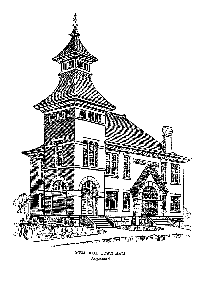

18 Chapters, 120 pictures, 469 pages
THE MEMORIAL TOWN HALL (p. 298)
("The Town Hall That Never Was")
I have no desire to revive, or to keep alive, any of the feeling which existed in different sections of the town on this subject, some twenty-five or more years ago. But I feel that a brief statement of some of the facts should be made, as part of our town history.
The question of building a Town Hall had been considered by the voters for many years. I have found articles in the warrant for town meetings in 1838, 1840 and 1844 relating to that matter. The article in the warrant calling the meeting in 1840 reads: "To see if the Town will vote to locate the Town House, if they agree to build one, on the Green so called near the house of John Adams." At the April meeting in 1885, the following article was in the warrant:
"Art. 16, To see if the Town will vote to erect a monument to the memory of the men of Wilbraham who died for their country in the war for the preservtion of the Union. and make all necessary appropriations, and choose a committee to carry the same into effect."
A committee of five was chosen to consider the matter and to report at a later meeting. About a month later the committee reported in favor of building a Memorial Toom Hall. and that it be located on the lot where the Soldiers' Monument now is, which is near the exact centre of the town.
The town accepted the report, voted to build and chose a committee of five to proceed with the work. At that time the lot was owned by James B. Crane of Dalton, whose mother was daughter of Gaius Brewer, who had lived on the lot for many years and until his death in 1843, when the place was occupied by his son John, until his death in 1860. The committee purchased the lot of James B. Crane for $500 from his brother, Zenas Crane, also of Dalton, paying one-half of the price, as a present to the town.
The committee selected a plan for a building and received bids for its erection.
But there were some in town who desired a different location, and a petition was presented to the Court, asking for an injunction to restrain the committee from going on with the work, claiming that the action of the town was illegal The hearing on the petition delayed matters until about the first of January, 1886, when the Supreme Court declared that the action taken by the town was legal.
A meeting of the building committee was held January 21st, 1886, and three bids were received for doing the work: One from Joseph Hayden of Springfield for $10,000; one from the Flynt Building & Construction Co. of Palmer for $9,080; a bid which I presented was lower than these, and the contract was awarded to me for $8,475. The winter of 1886 was very mild, and the excavation for the walls and basement was soon completed. The walls were to be of red sandstone, rough ashler work, to about four feet above the ground and then of brick. The stone for the foundation was drawn from an abandoned quarry on the west side of West Street, about opposite where Dr. James M. Pease now lives.
The stone for the rough ashler work, above the ground, was procured from the quarry at Sixteen Acres. The walls were all completed to four feet above the surface of the ground early in April. At the April town meeting, after a long discussion, the toom voted to accept the work that had been done and to go on and complete it.
The meeting was continued to about nine o'clock in the evening when, some of the voters having gone home, a motion to reconsider prevailed, and it was voted not to build.
Weary with the long strife, those who favored the project gave it up, and we have no townhall yet. A lawsuit was necessary before the contractor received pay for the work he had done, and it was about three years before the matter was settled.
The expense to the town was a little more than $3,000.
THE ELECTRIC RAILWAY (p. 300)
In March, 1870, the first horse-car was run on the street
railway in Springfield, and in 1890, part of their system of street
railways was equipped with electric motor cars and the use of
horse power was discontinued as rapidly as possible and the
"trolly" system adopted. The lines were gradually extended
and, on September 17th, 1901, the electric cars began running
regularly through the north part of our town. Efforts have
been made by our citizens to have the line extended along
Springfield Street to our centre village, and thence to North
Wilbraham to connect with the present line there, but without
success so far. The Street Railway and Excise tax received by
the town for the year ending February 22nd, 1913, was $4,518.15.
THE TELEPHONE (p. 301)
A private telephone line was constructed from North Wilbraham to
our centre village by Dr. S. Foskit and the Wesleyan
Academy, and its in use in 1880. About 1884, Dr. H. G.
Webber made use of the line. The charge at first was about
$30 per year, but about 1886 the price was raised to $100 per
year. The subscribers declined to pay the charge and the
telephones were removed.
In 1903, the public line was built and was in use about the middle of January, 1904.
On the 1st of January, 1914, there were about 106 subscribers on the several lines radiating from the "Collins House" at North Wilbraham, and the welcome tinkle of the "telephone call" is now heard in many of the homes throughout the entire territory of Wilbraham.
Merrick (1963)
Stebbins (1863)
Web pages courtesy of wilbraham.com